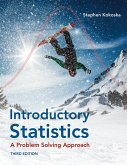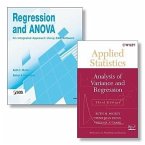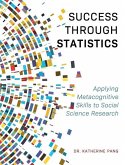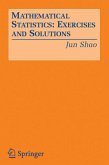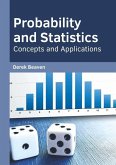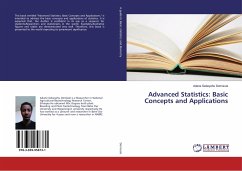- Broschiertes Buch
- Merkliste
- Auf die Merkliste
- Bewerten Bewerten
- Teilen
- Produkt teilen
- Produkterinnerung
- Produkterinnerung
Introductory Statistics: A Student-Centered Approach provides the key to understanding statistics in the real world for today's students. The authors started first with the needs of students, how they learn and digest new material, what's relevant to them, and how they practice their skills. They then built out an all-in-one offering designed to provide a pathway to understanding for all students and show why statistics matters in the modern world. Digital resources in Achieve connect the mission of the text to immersive learning experiences and multimedia with a variety of assessment types to fit any teaching style.…mehr
Andere Kunden interessierten sich auch für
![Introductory Statistics: A Problem-Solving Approach Introductory Statistics: A Problem-Solving Approach]() Stephen KokoskaIntroductory Statistics: A Problem-Solving Approach70,99 €
Stephen KokoskaIntroductory Statistics: A Problem-Solving Approach70,99 €![Regression and Anova: An Integrated Approach Using SAS Software + Applied Statistics: Analysis of Variance and Regression, Third Edition Set Regression and Anova: An Integrated Approach Using SAS Software + Applied Statistics: Analysis of Variance and Regression, Third Edition Set]() Keith E MullerRegression and Anova: An Integrated Approach Using SAS Software + Applied Statistics: Analysis of Variance and Regression, Third Edition Set248,99 €
Keith E MullerRegression and Anova: An Integrated Approach Using SAS Software + Applied Statistics: Analysis of Variance and Regression, Third Edition Set248,99 €![Success through Statistics: Applying Metacognitive Skills to Social Science Research Success through Statistics: Applying Metacognitive Skills to Social Science Research]() Katherine PangSuccess through Statistics: Applying Metacognitive Skills to Social Science Research214,99 €
Katherine PangSuccess through Statistics: Applying Metacognitive Skills to Social Science Research214,99 €![Mathematical Statistics: Exercises and Solutions Mathematical Statistics: Exercises and Solutions]() Jun ShaoMathematical Statistics: Exercises and Solutions112,99 €
Jun ShaoMathematical Statistics: Exercises and Solutions112,99 €![Probability and Statistics: Concepts and Applications Probability and Statistics: Concepts and Applications]() Probability and Statistics: Concepts and Applications129,99 €
Probability and Statistics: Concepts and Applications129,99 €![Advanced Statistics: Basic Concepts and Applications Advanced Statistics: Basic Concepts and Applications]() Adane Gebeyehu DemissieAdvanced Statistics: Basic Concepts and Applications46,99 €
Adane Gebeyehu DemissieAdvanced Statistics: Basic Concepts and Applications46,99 €![Foundations of Statistics: A Comprehensive Guide Foundations of Statistics: A Comprehensive Guide]() M. Moses Antony RajendranFoundations of Statistics: A Comprehensive Guide40,99 €
M. Moses Antony RajendranFoundations of Statistics: A Comprehensive Guide40,99 €-
-
-
Introductory Statistics: A Student-Centered Approach provides the key to understanding statistics in the real world for today's students. The authors started first with the needs of students, how they learn and digest new material, what's relevant to them, and how they practice their skills. They then built out an all-in-one offering designed to provide a pathway to understanding for all students and show why statistics matters in the modern world. Digital resources in Achieve connect the mission of the text to immersive learning experiences and multimedia with a variety of assessment types to fit any teaching style.
Produktdetails
- Produktdetails
- Verlag: Macmillan Learning
- Seitenzahl: 1008
- Erscheinungstermin: 15. Februar 2024
- Englisch
- Abmessung: 274mm x 216mm x 34mm
- Gewicht: 1864g
- ISBN-13: 9781319545314
- ISBN-10: 1319545319
- Artikelnr.: 70049526
- Herstellerkennzeichnung
- Libri GmbH
- Europaallee 1
- 36244 Bad Hersfeld
- gpsr@libri.de
- Verlag: Macmillan Learning
- Seitenzahl: 1008
- Erscheinungstermin: 15. Februar 2024
- Englisch
- Abmessung: 274mm x 216mm x 34mm
- Gewicht: 1864g
- ISBN-13: 9781319545314
- ISBN-10: 1319545319
- Artikelnr.: 70049526
- Herstellerkennzeichnung
- Libri GmbH
- Europaallee 1
- 36244 Bad Hersfeld
- gpsr@libri.de
Ann Cannon; Daren Starnes; Josh Tabor
Chapter 1 Collecting Data
Section 1.1 Introduction to Data Collection
Section 1.2 Sampling: Good and Bad
Section 1.3 Simple Random Sampling
Section 1.4 Other Sampling Methods
Section 1.5 Observational Studies and Experiments
Section 1.6 Completely Randomized Designs
Section 1.7 Blocking
Section 1.8 Data Ethics and the Scope of Inference
Chapter 2 Displaying Data with Graphs
Section 2.1 Displaying Categorical Data
Section 2.2 Displaying Relationships Between Two Categorical Variables
Section 2.3 Displaying Quantitative Data: Dotplots
Section 2.4 Displaying Quantitative Data: Stemplots
Section 2.5 Displaying Quantitative Data: Histograms
Section 2.6 Displaying Relationships Between Two Quantitative Variables
Chapter 3 Numerical Summaries for Quantitative Data
Section 3.1 Measuring Center
Section 3.2 Measuring Variability
Section 3.3 Boxplots and Outliers
Section 3.4 Measuring Location in a Distribution
Section 3.5 Relationships Between Two Variables: Correlation
Section 3.6 More About Correlation
Chapter 4 Probability
Section 4.1 Randomness, Probability, and Simulation
Section 4.2 Basic Probability Rules
Section 4.3 Two-Way Tables and Venn Diagrams
Section 4.4 Conditional Probability and Independence
Section 4.5 The General Multiplication Rule and Bayes' Theorem
Section 4.6 The Multiplication Rule for Independent Events
Section 4.7 The Multiplication Counting Principle and Permutations
Section 4.8 Combinations and Probability
Chapter 5 Discrete Random Variables
Section 5.1 Introduction to Random Variables
Section 5.2 Analyzing Discrete Random Variables
Section 5.3 Binomial Random Variables
Section 5.4 Analyzing Binomial Random Variables
Section 5.5 Poisson Random Variables
Chapter 6 Normal Distributions and Sampling Distributions
Section 6.1 Continuous Random Variables
Section 6.2 Normal Distributions: Finding Areas from Values
Section 6.3 Normal Distributions: Finding Values from Areas
Section 6.4 Normal Approximation to the Binomial Distribution and Assessing
Normality
Section 6.5 Sampling Distributions
Section 6.6 Sampling Distributions: Bias and Variability
Section 6.7 Sampling Distribution of the Sample Proportion
Section 6.8 Sampling Distribution of the Sample Mean and the Central Limit
Theorem
Chapter 7 Estimating a Parameter
Section 7.1 The Idea of a Confidence Interval
Section 7.2 Factors That Affect the Margin of Error
Section 7.3 Estimating a Population Proportion
Section 7.4 Confidence Intervals for a Population Proportion
Section 7.5 Estimating a Population Mean
Section 7.6 Confidence Intervals for a Population Mean
Section 7.7 Estimating a Population Standard Deviation or Variance
Section 7.8 Confidence Intervals for a Population Standard Deviation or
Variance
Chapter 8 Testing a Claim
Section 8.1 The Idea of a Significance Test
Section 8.2 Significance Tests and Decision Making
Section 8.3 Testing a Claim About a Population Proportion
Section 8.4 Significance Tests for a Population Proportion
Section 8.5 Testing a Claim About a Population Mean
Section 8.6 Significance Tests for a Population Mean
Section 8.7 Power of a Test
Section 8.8 Significance Tests for a Population Standard Deviation or
Variance
Chapter 9 Comparing Two Populations or Treatments
Section 9.1 Confidence Intervals for a Difference Between Two Population
Proportions
Section 9.2 Significance Tests for a Difference Between Two Population
Proportions
Section 9.3 Confidence Intervals for a Difference Between Two Population
Means
Section 9.4 Significance Tests for a Difference Between Two Population
Means
Section 9.5 Analyzing Paired Data: Confidence Intervals for a Population
Mean Difference
Section 9.6 Significance Tests for a Population Mean Difference
Section 9.7 Significance Tests for Two Population Standard Deviations or
Variances
Chapter 10 Chi-Square and Analysis of Variance (ANOVA)
Section 10.1 Testing the Distribution of a Categorical Variable in a
Population
Section 10.2 Chi-Square Tests for Goodness of Fit
Section 10.3 Testing the Relationship Between Two Categorical Variables in
a Population
Section 10.4 Chi-Square Tests for Association
Section 10.5 Introduction to Analysis of Variance
Section 10.6 One-Way Analysis of Variance
Chapter 11 Linear Regression
Section 11.1 Regression Lines
Section 11.2 The Least-Squares Regression Line
Section 11.3 Assessing a Regression Model
Section 11.4 Confidence Intervals for the Slope of a Population
Least-Squares Regression Line
Section 11.5 Significance Tests for the Slope of a Population Least-Squares
Regression Line
Section 11.6 Confidence Intervals for a Mean Response and Prediction
Intervals in Regression
Chapter 12 Multiple Regression
Section 12.1 Introduction to Multiple Regression
Section 12.2 Indicator Variables and Interaction
Section 12.3 Inference for Multiple Regression
Chapter 13 Nonparametric Methods
Section 13.1 The Sign Test
Section 13.2 The Wilcoxon Signed Rank Test
Section 13.3 The Wilcoxon Rank Sum Test
Section 13.4 The Kruskal-Wallis Test
Section 13.5 Randomization Tests
Section 13.6 Bootstrapping
Section 1.1 Introduction to Data Collection
Section 1.2 Sampling: Good and Bad
Section 1.3 Simple Random Sampling
Section 1.4 Other Sampling Methods
Section 1.5 Observational Studies and Experiments
Section 1.6 Completely Randomized Designs
Section 1.7 Blocking
Section 1.8 Data Ethics and the Scope of Inference
Chapter 2 Displaying Data with Graphs
Section 2.1 Displaying Categorical Data
Section 2.2 Displaying Relationships Between Two Categorical Variables
Section 2.3 Displaying Quantitative Data: Dotplots
Section 2.4 Displaying Quantitative Data: Stemplots
Section 2.5 Displaying Quantitative Data: Histograms
Section 2.6 Displaying Relationships Between Two Quantitative Variables
Chapter 3 Numerical Summaries for Quantitative Data
Section 3.1 Measuring Center
Section 3.2 Measuring Variability
Section 3.3 Boxplots and Outliers
Section 3.4 Measuring Location in a Distribution
Section 3.5 Relationships Between Two Variables: Correlation
Section 3.6 More About Correlation
Chapter 4 Probability
Section 4.1 Randomness, Probability, and Simulation
Section 4.2 Basic Probability Rules
Section 4.3 Two-Way Tables and Venn Diagrams
Section 4.4 Conditional Probability and Independence
Section 4.5 The General Multiplication Rule and Bayes' Theorem
Section 4.6 The Multiplication Rule for Independent Events
Section 4.7 The Multiplication Counting Principle and Permutations
Section 4.8 Combinations and Probability
Chapter 5 Discrete Random Variables
Section 5.1 Introduction to Random Variables
Section 5.2 Analyzing Discrete Random Variables
Section 5.3 Binomial Random Variables
Section 5.4 Analyzing Binomial Random Variables
Section 5.5 Poisson Random Variables
Chapter 6 Normal Distributions and Sampling Distributions
Section 6.1 Continuous Random Variables
Section 6.2 Normal Distributions: Finding Areas from Values
Section 6.3 Normal Distributions: Finding Values from Areas
Section 6.4 Normal Approximation to the Binomial Distribution and Assessing
Normality
Section 6.5 Sampling Distributions
Section 6.6 Sampling Distributions: Bias and Variability
Section 6.7 Sampling Distribution of the Sample Proportion
Section 6.8 Sampling Distribution of the Sample Mean and the Central Limit
Theorem
Chapter 7 Estimating a Parameter
Section 7.1 The Idea of a Confidence Interval
Section 7.2 Factors That Affect the Margin of Error
Section 7.3 Estimating a Population Proportion
Section 7.4 Confidence Intervals for a Population Proportion
Section 7.5 Estimating a Population Mean
Section 7.6 Confidence Intervals for a Population Mean
Section 7.7 Estimating a Population Standard Deviation or Variance
Section 7.8 Confidence Intervals for a Population Standard Deviation or
Variance
Chapter 8 Testing a Claim
Section 8.1 The Idea of a Significance Test
Section 8.2 Significance Tests and Decision Making
Section 8.3 Testing a Claim About a Population Proportion
Section 8.4 Significance Tests for a Population Proportion
Section 8.5 Testing a Claim About a Population Mean
Section 8.6 Significance Tests for a Population Mean
Section 8.7 Power of a Test
Section 8.8 Significance Tests for a Population Standard Deviation or
Variance
Chapter 9 Comparing Two Populations or Treatments
Section 9.1 Confidence Intervals for a Difference Between Two Population
Proportions
Section 9.2 Significance Tests for a Difference Between Two Population
Proportions
Section 9.3 Confidence Intervals for a Difference Between Two Population
Means
Section 9.4 Significance Tests for a Difference Between Two Population
Means
Section 9.5 Analyzing Paired Data: Confidence Intervals for a Population
Mean Difference
Section 9.6 Significance Tests for a Population Mean Difference
Section 9.7 Significance Tests for Two Population Standard Deviations or
Variances
Chapter 10 Chi-Square and Analysis of Variance (ANOVA)
Section 10.1 Testing the Distribution of a Categorical Variable in a
Population
Section 10.2 Chi-Square Tests for Goodness of Fit
Section 10.3 Testing the Relationship Between Two Categorical Variables in
a Population
Section 10.4 Chi-Square Tests for Association
Section 10.5 Introduction to Analysis of Variance
Section 10.6 One-Way Analysis of Variance
Chapter 11 Linear Regression
Section 11.1 Regression Lines
Section 11.2 The Least-Squares Regression Line
Section 11.3 Assessing a Regression Model
Section 11.4 Confidence Intervals for the Slope of a Population
Least-Squares Regression Line
Section 11.5 Significance Tests for the Slope of a Population Least-Squares
Regression Line
Section 11.6 Confidence Intervals for a Mean Response and Prediction
Intervals in Regression
Chapter 12 Multiple Regression
Section 12.1 Introduction to Multiple Regression
Section 12.2 Indicator Variables and Interaction
Section 12.3 Inference for Multiple Regression
Chapter 13 Nonparametric Methods
Section 13.1 The Sign Test
Section 13.2 The Wilcoxon Signed Rank Test
Section 13.3 The Wilcoxon Rank Sum Test
Section 13.4 The Kruskal-Wallis Test
Section 13.5 Randomization Tests
Section 13.6 Bootstrapping
Chapter 1 Collecting Data
Section 1.1 Introduction to Data Collection
Section 1.2 Sampling: Good and Bad
Section 1.3 Simple Random Sampling
Section 1.4 Other Sampling Methods
Section 1.5 Observational Studies and Experiments
Section 1.6 Completely Randomized Designs
Section 1.7 Blocking
Section 1.8 Data Ethics and the Scope of Inference
Chapter 2 Displaying Data with Graphs
Section 2.1 Displaying Categorical Data
Section 2.2 Displaying Relationships Between Two Categorical Variables
Section 2.3 Displaying Quantitative Data: Dotplots
Section 2.4 Displaying Quantitative Data: Stemplots
Section 2.5 Displaying Quantitative Data: Histograms
Section 2.6 Displaying Relationships Between Two Quantitative Variables
Chapter 3 Numerical Summaries for Quantitative Data
Section 3.1 Measuring Center
Section 3.2 Measuring Variability
Section 3.3 Boxplots and Outliers
Section 3.4 Measuring Location in a Distribution
Section 3.5 Relationships Between Two Variables: Correlation
Section 3.6 More About Correlation
Chapter 4 Probability
Section 4.1 Randomness, Probability, and Simulation
Section 4.2 Basic Probability Rules
Section 4.3 Two-Way Tables and Venn Diagrams
Section 4.4 Conditional Probability and Independence
Section 4.5 The General Multiplication Rule and Bayes' Theorem
Section 4.6 The Multiplication Rule for Independent Events
Section 4.7 The Multiplication Counting Principle and Permutations
Section 4.8 Combinations and Probability
Chapter 5 Discrete Random Variables
Section 5.1 Introduction to Random Variables
Section 5.2 Analyzing Discrete Random Variables
Section 5.3 Binomial Random Variables
Section 5.4 Analyzing Binomial Random Variables
Section 5.5 Poisson Random Variables
Chapter 6 Normal Distributions and Sampling Distributions
Section 6.1 Continuous Random Variables
Section 6.2 Normal Distributions: Finding Areas from Values
Section 6.3 Normal Distributions: Finding Values from Areas
Section 6.4 Normal Approximation to the Binomial Distribution and Assessing
Normality
Section 6.5 Sampling Distributions
Section 6.6 Sampling Distributions: Bias and Variability
Section 6.7 Sampling Distribution of the Sample Proportion
Section 6.8 Sampling Distribution of the Sample Mean and the Central Limit
Theorem
Chapter 7 Estimating a Parameter
Section 7.1 The Idea of a Confidence Interval
Section 7.2 Factors That Affect the Margin of Error
Section 7.3 Estimating a Population Proportion
Section 7.4 Confidence Intervals for a Population Proportion
Section 7.5 Estimating a Population Mean
Section 7.6 Confidence Intervals for a Population Mean
Section 7.7 Estimating a Population Standard Deviation or Variance
Section 7.8 Confidence Intervals for a Population Standard Deviation or
Variance
Chapter 8 Testing a Claim
Section 8.1 The Idea of a Significance Test
Section 8.2 Significance Tests and Decision Making
Section 8.3 Testing a Claim About a Population Proportion
Section 8.4 Significance Tests for a Population Proportion
Section 8.5 Testing a Claim About a Population Mean
Section 8.6 Significance Tests for a Population Mean
Section 8.7 Power of a Test
Section 8.8 Significance Tests for a Population Standard Deviation or
Variance
Chapter 9 Comparing Two Populations or Treatments
Section 9.1 Confidence Intervals for a Difference Between Two Population
Proportions
Section 9.2 Significance Tests for a Difference Between Two Population
Proportions
Section 9.3 Confidence Intervals for a Difference Between Two Population
Means
Section 9.4 Significance Tests for a Difference Between Two Population
Means
Section 9.5 Analyzing Paired Data: Confidence Intervals for a Population
Mean Difference
Section 9.6 Significance Tests for a Population Mean Difference
Section 9.7 Significance Tests for Two Population Standard Deviations or
Variances
Chapter 10 Chi-Square and Analysis of Variance (ANOVA)
Section 10.1 Testing the Distribution of a Categorical Variable in a
Population
Section 10.2 Chi-Square Tests for Goodness of Fit
Section 10.3 Testing the Relationship Between Two Categorical Variables in
a Population
Section 10.4 Chi-Square Tests for Association
Section 10.5 Introduction to Analysis of Variance
Section 10.6 One-Way Analysis of Variance
Chapter 11 Linear Regression
Section 11.1 Regression Lines
Section 11.2 The Least-Squares Regression Line
Section 11.3 Assessing a Regression Model
Section 11.4 Confidence Intervals for the Slope of a Population
Least-Squares Regression Line
Section 11.5 Significance Tests for the Slope of a Population Least-Squares
Regression Line
Section 11.6 Confidence Intervals for a Mean Response and Prediction
Intervals in Regression
Chapter 12 Multiple Regression
Section 12.1 Introduction to Multiple Regression
Section 12.2 Indicator Variables and Interaction
Section 12.3 Inference for Multiple Regression
Chapter 13 Nonparametric Methods
Section 13.1 The Sign Test
Section 13.2 The Wilcoxon Signed Rank Test
Section 13.3 The Wilcoxon Rank Sum Test
Section 13.4 The Kruskal-Wallis Test
Section 13.5 Randomization Tests
Section 13.6 Bootstrapping
Section 1.1 Introduction to Data Collection
Section 1.2 Sampling: Good and Bad
Section 1.3 Simple Random Sampling
Section 1.4 Other Sampling Methods
Section 1.5 Observational Studies and Experiments
Section 1.6 Completely Randomized Designs
Section 1.7 Blocking
Section 1.8 Data Ethics and the Scope of Inference
Chapter 2 Displaying Data with Graphs
Section 2.1 Displaying Categorical Data
Section 2.2 Displaying Relationships Between Two Categorical Variables
Section 2.3 Displaying Quantitative Data: Dotplots
Section 2.4 Displaying Quantitative Data: Stemplots
Section 2.5 Displaying Quantitative Data: Histograms
Section 2.6 Displaying Relationships Between Two Quantitative Variables
Chapter 3 Numerical Summaries for Quantitative Data
Section 3.1 Measuring Center
Section 3.2 Measuring Variability
Section 3.3 Boxplots and Outliers
Section 3.4 Measuring Location in a Distribution
Section 3.5 Relationships Between Two Variables: Correlation
Section 3.6 More About Correlation
Chapter 4 Probability
Section 4.1 Randomness, Probability, and Simulation
Section 4.2 Basic Probability Rules
Section 4.3 Two-Way Tables and Venn Diagrams
Section 4.4 Conditional Probability and Independence
Section 4.5 The General Multiplication Rule and Bayes' Theorem
Section 4.6 The Multiplication Rule for Independent Events
Section 4.7 The Multiplication Counting Principle and Permutations
Section 4.8 Combinations and Probability
Chapter 5 Discrete Random Variables
Section 5.1 Introduction to Random Variables
Section 5.2 Analyzing Discrete Random Variables
Section 5.3 Binomial Random Variables
Section 5.4 Analyzing Binomial Random Variables
Section 5.5 Poisson Random Variables
Chapter 6 Normal Distributions and Sampling Distributions
Section 6.1 Continuous Random Variables
Section 6.2 Normal Distributions: Finding Areas from Values
Section 6.3 Normal Distributions: Finding Values from Areas
Section 6.4 Normal Approximation to the Binomial Distribution and Assessing
Normality
Section 6.5 Sampling Distributions
Section 6.6 Sampling Distributions: Bias and Variability
Section 6.7 Sampling Distribution of the Sample Proportion
Section 6.8 Sampling Distribution of the Sample Mean and the Central Limit
Theorem
Chapter 7 Estimating a Parameter
Section 7.1 The Idea of a Confidence Interval
Section 7.2 Factors That Affect the Margin of Error
Section 7.3 Estimating a Population Proportion
Section 7.4 Confidence Intervals for a Population Proportion
Section 7.5 Estimating a Population Mean
Section 7.6 Confidence Intervals for a Population Mean
Section 7.7 Estimating a Population Standard Deviation or Variance
Section 7.8 Confidence Intervals for a Population Standard Deviation or
Variance
Chapter 8 Testing a Claim
Section 8.1 The Idea of a Significance Test
Section 8.2 Significance Tests and Decision Making
Section 8.3 Testing a Claim About a Population Proportion
Section 8.4 Significance Tests for a Population Proportion
Section 8.5 Testing a Claim About a Population Mean
Section 8.6 Significance Tests for a Population Mean
Section 8.7 Power of a Test
Section 8.8 Significance Tests for a Population Standard Deviation or
Variance
Chapter 9 Comparing Two Populations or Treatments
Section 9.1 Confidence Intervals for a Difference Between Two Population
Proportions
Section 9.2 Significance Tests for a Difference Between Two Population
Proportions
Section 9.3 Confidence Intervals for a Difference Between Two Population
Means
Section 9.4 Significance Tests for a Difference Between Two Population
Means
Section 9.5 Analyzing Paired Data: Confidence Intervals for a Population
Mean Difference
Section 9.6 Significance Tests for a Population Mean Difference
Section 9.7 Significance Tests for Two Population Standard Deviations or
Variances
Chapter 10 Chi-Square and Analysis of Variance (ANOVA)
Section 10.1 Testing the Distribution of a Categorical Variable in a
Population
Section 10.2 Chi-Square Tests for Goodness of Fit
Section 10.3 Testing the Relationship Between Two Categorical Variables in
a Population
Section 10.4 Chi-Square Tests for Association
Section 10.5 Introduction to Analysis of Variance
Section 10.6 One-Way Analysis of Variance
Chapter 11 Linear Regression
Section 11.1 Regression Lines
Section 11.2 The Least-Squares Regression Line
Section 11.3 Assessing a Regression Model
Section 11.4 Confidence Intervals for the Slope of a Population
Least-Squares Regression Line
Section 11.5 Significance Tests for the Slope of a Population Least-Squares
Regression Line
Section 11.6 Confidence Intervals for a Mean Response and Prediction
Intervals in Regression
Chapter 12 Multiple Regression
Section 12.1 Introduction to Multiple Regression
Section 12.2 Indicator Variables and Interaction
Section 12.3 Inference for Multiple Regression
Chapter 13 Nonparametric Methods
Section 13.1 The Sign Test
Section 13.2 The Wilcoxon Signed Rank Test
Section 13.3 The Wilcoxon Rank Sum Test
Section 13.4 The Kruskal-Wallis Test
Section 13.5 Randomization Tests
Section 13.6 Bootstrapping


